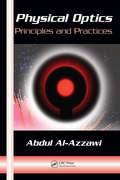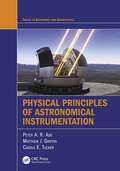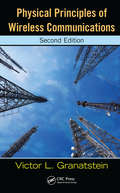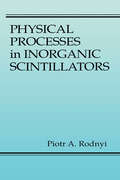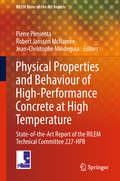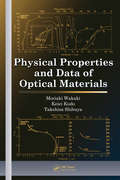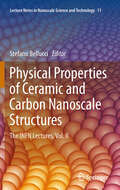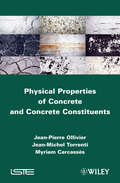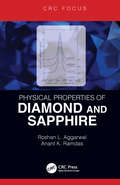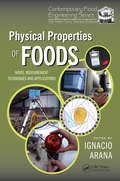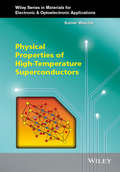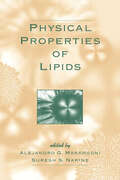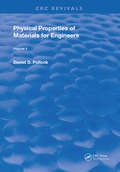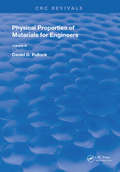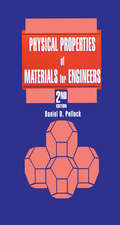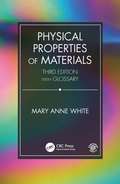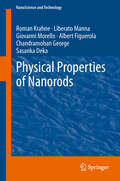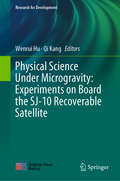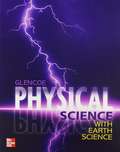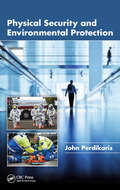- Table View
- List View
Physical Optics: Principles and Practices
by Abdul Al-AzzawiSince the invention of the laser, our fascination with the photon has led to one of the most dynamic and rapidly growing fields of technology. As the reality of all-optical systems comes into focus, it is more important than ever to stay current with the latest advances in the optics and components that enable photonics technology. Comprising chapters drawn from the author's highly anticipated book Photonics: Principles and Practices, Physical Optics: Principles and Practices offers a detailed and focused treatment for anyone in need of authoritative information on this critical area underlying photonics.Using a consistent approach, the author leads you step-by-step through each topic. Each skillfully crafted chapter first explores the theoretical concepts of each topic, and then demonstrates how these principles apply to real-world applications by guiding you through experimental cases illuminated with numerous illustrations. The book works systematically through the principles of waves, diffraction, interference, diffraction gratings, interferometers, spectrometers, and several aspects of laser technology to build a thorough understanding of how to study and manipulate the behavior of light for various applications. In addition, it includes a four-page insert containing several full-color illustrations as well as a chapter on laboratory safety.Containing several topics presented for the first time in book form, Physical Optics: Principles and Practices is simply the most modern, detailed, and hands-on text in the field.
Physical Principles of Astronomical Instrumentation (Series in Astronomy and Astrophysics)
by Peter A. Ade Matthew J. Griffin Carole E. TuckerOffering practical advice on a range of wavelengths, this highly accessible and self-contained book presents a broad overview of astronomical instrumentation, techniques, and tools. Drawing on the notes and lessons of the authors’ established graduate course, the text reviews basic concepts in astrophysics, spectroscopy, and signal analysis. It includes illustrative problems and case studies and aims to provide readers with a toolbox for observational capabilities across the electromagnetic spectrum and the knowledge to understand which tools are best suited to different observations. It is an ideal guide for undergraduates and graduates studying astronomy. Features: Presents a self-contained account of a highly complex subject. Offers practical advice and instruction on a wide range of wavelengths and tools. Includes case studies and problems for further learning opportunities.
Physical Principles of Food Preservation: Revised and Expanded
by Marcus Karel Daryl LundThis reference examines the properties, conditions, and theoretical principles governing the safety and efficacy of various food preservation, storage, and packaging techniques. The book analyzes methods to predict and optimize the nutrition, texture, and quality of food compounds while reducing operating cost and waste. The Second Edition contains new chapters and discussions on non-thermal processes; the mechanisms of heat transfer, including conduction, convection, radiation, and dielectric and microwave heating; the kinetic parameters of food process operations; freezing technology, using illustrative examples; recent breakthroughs in cryochemistry and cryobiology, and more.
Physical Principles of Remote Sensing
by W. G. ReesFully updated and containing significant new material on photography, laser profiling and image processing, the third edition of this popular textbook covers a broad range of remote sensing applications and techniques across the Earth, environmental and planetary sciences. It focuses on physical principles, giving students a deeper understanding of remote sensing systems and their possibilities, while remaining accessible to those with less mathematical training by providing a step-by-step approach to quantitative topics. Boxed examples, additional photos and numerous colour images engage students and show them how the theory relates to the many real-world applications. Chapter summaries, review questions and additional problems allow students to check their understanding of key concepts and practise handling real data for themselves. Supplementary online material includes links to freely available software, animations, computer programs, colour images and other web-based resources of interest.
Physical Principles of Wireless Communications
by Victor L. GranatsteinUpdated and expanded, Physical Principles of Wireless Communications, Second Edition illustrates the relationship between scientific discoveries and their application to the invention and engineering of wireless communication systems. The second edition of this popular textbook starts with a review of the relevant physical laws, including
Physical Processes in Inorganic Scintillators (Laser And Optical Science And Technology Ser. #14)
by Piotr A. RodnyiDuring the last ten to fifteen years, researchers have made considerable progress in the study of inorganic scintillators. New scintillation materials have been investigated, novel scintillation mechanisms have been discovered, and additional scintillator applications have appeared. Demand continues for new and improved scintillation materials for a variety of applications including nuclear and high energy physics, astrophysics, medical imaging, geophysical exploration, radiation detection, and many other fields. However, until now there have been no books available that address in detail the complex scintillation processes associated with these new developments.Now, a world leader in the theory and applications of scintillation processes integrates the latest scientific advances of scintillation into a new work, Physical Processes in Inorganic Scintillators. Written by distinguished researcher Piotr Rodnyi, this volume explores this challenging subject, explains the complexities of scintillation from a modern point of view, and illuminates the way to the development of better scintillation materials.This unique work first defines the fundamental physical processes underlying scintillation and governing the primary scintillation characteristics of light output, decay time, emission spectrum, and radiation hardness. The book then discusses the complicated mechanisms of energy conversion and transformation in inorganic scintillators. The section on the role of defects in energy transfer and scintillation efficiency will be of special interest. Throughout, the author does not offer complicated derivations of equations but, instead, presents useful equations with practical results.
Physical Properties and Behaviour of High-Performance Concrete at High Temperature: State-of-the-Art Report of the RILEM Technical Committee 227-HPB (RILEM State-of-the-Art Reports #29)
by Pierre Pimienta Robert Jansson McNamee Jean-Christophe MindeguiaThis book presents the work done by the RILEM Technical Committee 227-HPB (Physical properties and behaviour of High-Performance Concrete at high temperature). It contains the latest research results on the behaviour of high-performance concretes at high temperature. The book presents the state of the art of experimental data on High-Performance concretes and it collects and synthesizes useful data about concrete behaviour at high temperatures. The book is divided into independent chapters dealing with degradation reactions in concrete exposed to high temperatures; mass transport properties; thermal properties; and mechanical properties. The results presented especially target a group of users composed by universities and testing laboratories, building material companies and industries, material scientists and experts, building and infrastructure authorities, designers and civil engineers.
Physical Properties and Data of Optical Materials
by Moriaki Wakaki Takehisa Shibuya Keiei KudoResearch and applications in optical engineering require careful selection of materials. With such a large and varied array to choose from, it is important to understand a material's physical and optical properties before making a selection. Providing a convenient, concise, and logically organized collection of information, Physical Properties and Data of Optical Materials builds a thorough background for more than 100 optical materials and offers quick access to precise information. Surveying the most important and widely used optical materials, this handy reference includes data on a wide variety of metals, semiconductors, dielectrics, polymers, and other commonly used optical materials. For each material, the editors examine the crystal system; natural and artificial growth and production methods along with corrosives and processing; thermal, electrical, and mechanical properties; optical properties, such as transmittance and reflectance spectra, ranging from UV to IR wavelengths; and, where applicable, applications for spectroscopy and miscellaneous remarks such as handling concerns and chemical properties. Numerous tables illustrate important data such as numerical values of optical constants for important wavelength regions, extinction and absorption coefficients, and refractive index. Physical Properties and Data of Optical Materials offers a collection of data on an unprecedented variety of fundamental optical materials, making it the one quick-lookup guide that every optical scientist, engineer, and student should own.
Physical Properties of Ceramic and Carbon Nanoscale Structures
by Stefano BellucciThis is the second volume in a series of books on selected topics in Nanoscale Science and Technology based on lectures given at the well-known INFN schools of the same name. The aim of this collection is to provide a reference corpus of suitable, introductory material to relevant subfields, as they mature over time, by gathering the significantly expanded and edited versions of tutorial lectures, given over the years by internationally known experts. The present set of notes stems in particular from the participation and dedication of prestigious lecturers, such as Andrzej Huczko, Nicola Pugno, Alexander Malesevic, Pasquale Onorato and Stefano Bellucci. All lectures were subsequently carefully edited and reworked, taking into account the extensive follow-up discussions. A tutorial lecture by Huczko et al. shows how a variety of carbon and ceramic nanostructures (nanotubes, nanowires, nanofibres, nanorods, and nanoencapsulates) have in particular great potential for improving our understanding of the fundamental concepts of the roles of both dimensionality and size on physical material properties . Bellucci and Onorato provide an extensive and tutorial review of the (quantum) transport properties in carbon nanotubes, encompassing a description of the electronic structure from graphene to single-wall nanotubes, as well as a discussion of experimental evidence of superconductivity in carbon nanotubes and the corresponding theoretical interpretation. In the first contribution by Pugno, new ideas on how to design futuristic self-cleaning, super-adhesive and releasable hierarchical smart materials are presented. He also reviews the mechanical strength of such nanotubes and megacables, with an eye to the visionary project of a carbon nanotube-based 'space elevator megacable'. In his second contribution, Pugno outlines in detail the role on the fracture strength of thermodynamically unavoidable atomistic defects with different size and shape, both numerically and theoretically, for nanotubes and nanotube bundles. Focusing on graphitic allotropes, the chapter by Bellucci and Malesevic aims to give a taste of the widespread implications carbon nanostructures have on research and applications, starting from an historical overview, followed by a discussion of the structure and physical properties of carbon nanotubes and graphene, in particular in the context of the several different synthesis techniques presently available.
Physical Properties of Concrete and Concrete Constituents
by Jean-Pierre Ollivier Myriam Carcasses Jean-Michel ToorentiUnderstanding the rheological properties of fresh concrete, the hydration phenomenon of cement responsible for structuration, the relationship between the characteristics of the porous solid obtained and its mechanical performances or resistance to the aggressive penetration requires a complex knowledge of the physicochemistry of reactive porous materials. The development of simple formulation rules therefore requires the assimilation of this knowledge and a good command of the properties of these materials.The purpose of this book is to provide the mix designer with useful knowledge on granular materials and porous materials, which will enable the innovative design of concrete. Topics covered include the characterization of granular materials, the concepts of porosity and specific surface area, and the transport properties (diffusion and permeation) of concrete. Some of these topics are already covered in other general books dedicated to granular or porous materials. The objective here is to bring them together in one book by adapting them for use by concrete specialists.Applications in the form of exercises are offered at the end of each chapter to enable readers to assimilate the theoretical knowledge and to apply such knowledge to concrete problems encountered in civil engineering. Contents 1. Description of Granular Materials, Definitions.2. Granulometry.3. Specific Surface Area of Materials.4. Voids in Granular Materials and the Arrangement of Grains.5. Voids in Concrete.6. The Fundamentals of Diffusion.7. Permeability.
Physical Properties of Diamond and Sapphire
by Roshan L. Aggarwal Anant K. RamdasFocusing on the physical properties of diamond and sapphire, this monograph provides readers with essential details on crystal structure and growth, mechanical properties, thermal properties, optical properties, light scattering of diamond and sapphire crystals, and sapphire lasers. Various physical properties are comprehensively discussed: Mechanical properties include hardness, tensile strength, compressive strength, and Young’s modulus. Thermal properties include thermal expansion, specific heat, and thermal conductivity. Optical properties of diamond and sapphire include transmission, refractive index, and absorption. Light scattering includes Raman scattering and Brillouin scattering. Sapphire lasers include chromium-doped and titanium-doped lasers. Aimed at researchers and industry professionals working in materials science, physics, electrical engineering, and related fields, this monograph is the first to concentrate solely on physical properties of these increasingly important materials.
Physical Properties of Foods: Novel Measurement Techniques and Applications (Contemporary Food Engineering)
by Ignacio AranaWith higher food quality in increasing demand by consumers, there is continuous pressure on food engineers to meet market needs. One of the critical challenges is to use modern technology and knowledge to develop new processes for improving food quality. Given the global food marketplace, there is also a greater need for a means of objectively clas
Physical Properties of High-Temperature Superconductors
by Rainer WescheA much-needed update on complex high-temperature superconductors, focusing on materials aspects; this timely book coincides with a recent major break-through of the discovery of iron-based superconductors. It provides an overview of materials aspects of high-temperature superconductors, combining introductory aspects, description of new physics, material aspects, and a description of the material properties This title is suitable for researchers in materials science, physics and engineering. Also for technicians interested in the applications of superconductors, e. g. as biomagnets
Physical Properties of Lipids
by Alejandro G. Marangoni Suresh S. NarineProvides in-depth coverage of the physical properties of fats and oils. Includes surface and theological characteristics as well as crystallization and phase behavior for improved nutrition and functionality in the design of new food products.
Physical Properties of Materials For Engineers: Volume 2
by Daniel D. PollockPracticing engineers will find this text helpful in getting up to date. Readers with some familiarity with this field will be able to follow the presentations with ease. Engineering students and those taking physics courses will find this book to be a useful source of examples of applications of the theory to commercially available materials as well as for uncomplicated explanations of physical properties. In many cases alternate explanations have been provided for clarity.An effort has been made to keep mathematics as an unsophisticated as possible withoutwatering down or distorting the concepts. In practically all cases only a master of elementary calculus is required to follow the derivations. All of thealgebra is shown and no steps in the derivations are considered to be obvious to the reader. Explanations are provided in cases where more advanced mathematics is employed The problems have been designed to promote understanding rather than mathematical or computational skill.
Physical Properties of Materials For Engineers: Volume 3
by Daniel D. PollockPracticing engineers will find this text helpful in getting up to date. Readers with some familiarity with this field will be able to follow the presentations with ease. Engineering students and those taking physics courses will find this book to be a useful source of examples of applications of the theory to commercially available materials as well as for uncomplicated explanations of physical properties. In many cases alternate explanations have been provided for clarity.An effort has been made to keep mathematics as an unsophisticated as possible withoutwatering down or distorting the concepts. In practically all cases only a master of elementary calculus is required to follow the derivations. All of thealgebra is shown and no steps in the derivations are considered to be obvious to the reader. Explanations are provided in cases where more advanced mathematics is employed The problems have been designed to promote understanding rather than mathematical or computational skill.
Physical Properties of Materials for Engineers
by Daniel D. PollockPhysical Properties of Materials for Engineers, Second Edition introduces and explains modern theories of the properties of materials and devices for practical use by engineers. Introductory chapters discuss both classical mechanics and quantum mechanics to demonstrate the need for the quantum approach. Topics are presented in an uncomplicated manner; extensive cross-references are provided to emphasize the inter-relationships among the physical phenomena. Illustrations and problems based on commercially-available materials are included where appropriate. Physical Properties of Materials for Engineers, Second Edition is an excellent introduction to solid state physics and practical techniques for students and workers in aerospace industry, chemical engineering, civil engineering, electrical engineering, industrial engineering, materials science, and mechanical and metallurgical engineering.
Physical Properties of Materials, Third Edition
by Mary Anne WhiteDesigned for advanced undergraduate students and as a useful reference book for materials researchers, Physical Properties of Materials, Third Edition establishes the principles that control the optical, thermal, electronic, magnetic, and mechanical properties of materials. Using an atomic and molecular approach, this introduction to materials science offers readers a wide-ranging survey of the field and a basis to understand future materials. The author incorporates comments on applications of materials science, extensive references to the contemporary and classic literature, and 350 end-of-chapter problems. In addition, unique tutorials allow students to apply the principles to understand applications, such as photocopying, magnetic devices, fiber optics, and more. This fully revised and updated Third Edition includes new materials and processes, such as topological insulators, 3-D printing, and more information on nanomaterials. The new edition also now adds Learning Goals at the end of each chapter and a Glossary with more than 500 entries for quick reference. Web ResourceThe book’s companion website (www.physicalpropertiesofmaterials.com) provides updates to the further reading sections and links to videos made specifically by the author for this book. It also offers sources of demonstration materials for lectures and PowerPoint slides of figures from the book. Many of the features (all those under Student Resources) are freely available to all, including about 30 custom made videos that specifically complement the contents of the book. These videos are highlighted at the appropriate points in the text. The book website also has many links to relevant websites around the world, sorted by chapter, to be used by students, instructors and materials researchers.
Physical Properties of Nanorods
by Albert Figuerola Chandramohan George Giovanni Morello Liberato Manna Roman Krahne Sasanka DekaInorganic nanoparticles are among the most investigated objects nowadays, both in fundamental science and in various technical applications. In this book the physical properties of nanowires formed by nanoparticles with elongated shape, i.e. rod-like or wire-like, are described. The transition in the physical properties is analyzed for nanorods and nanowires consisting of spherical and rod-like nanoparticles. The physical properties of nanowires and elongated inorganic nanoparticles are reviewed too. The optical, electrical, magnetic, mechanical and catalytic properties of nanowires consisting of semiconductors, noble and various other metals, metal oxides properties and metal alloys are presented. The applications of nanorods and nanowires are discussed in the book.
Physical Science Under Microgravity: Experiments on Board the SJ-10 Recoverable Satellite (Research for Development)
by Wenrui Hu Qi KangThis book presents the physical science experiments in a space microgravity environment conducted on board the SJ-10 recoverable satellite, which was launched on April 6th, 2016 and recovered on April 18th, 2016. The experiments described were selected from ~100 proposals from various institutions in China and around the world, and have never previously been conducted in the respective fields. They involve fluid physics and materials science, and primarily investigate the kinetic properties of matter in a space microgravity environment. The book provides a comprehensive review of these experiments, as well as the mission’s execution, data collection, and scientific outcomes.
Physical Science with Earth Science
by Charles William Mclaughlin Marilyn Thompson Ralph FeatherNIMAC-sourced textbook
Physical Science with Earth Science
by Dinah Zike Charles William Mclaughlin Marilyn Thompson Ralph FeatherThe book covers different topics that can be classified under the two main categories Earth science ( that investigates Earth and space) and Physical science (that studies matter and energy.)
Physical Science: Concepts in Action
by Michael Wysession David Frank Sophia YancopoulosNIMAC-sourced textbook
Physical Science: Concepts in Action, With Earth and Space Science
by Michael Wysession Sophia Yancopoulos David V. FrankPhysical Science is the study of non-living systems, as opposed to a study of biological sciences or living systems. It consists of physics, chemistry, astronomy and earth science. It also includes scientific method and experimentation and this is what this textbook is all about.
Physical Security and Environmental Protection
by John PerdikarisManage a Hazard or Threat Effectively and Prevent It from Becoming a DisasterWhen disaster strikes, it can present challenges to those caught off guard, leaving them to cope with the fallout. Adopting a risk management approach to addressing threats, vulnerability, and risk assessments is critical to those on the frontline. Developed with first res
